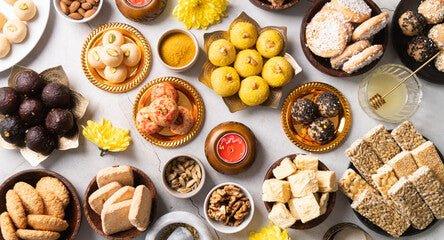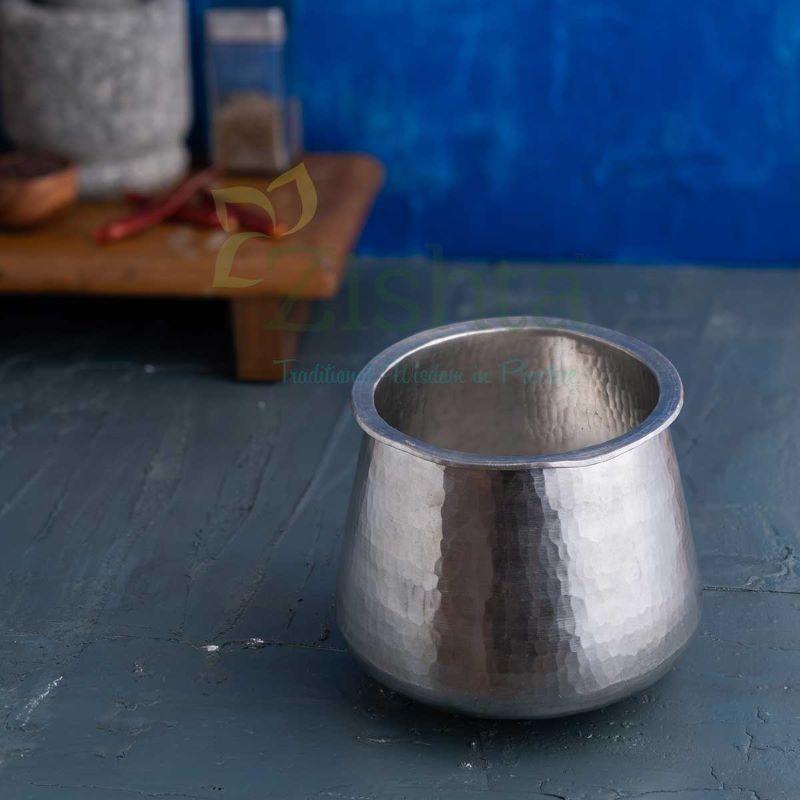India is a land of diverse cultures and traditions, and this diversity is reflected in its festival snacks. Festivals in India are often associated with special foods and snacks that are prepared to celebrate the occasion.
The tradition of preparing festival snacks in India is deeply rooted in the country's rich culture and heritage. Several cultural and social aspects contribute to the significance of festival snack preparations:
- Religious and Ritual Significance: Many festivals in India have religious or cultural significance, and specific snacks are prepared to pay homage to deities or commemorate historical events. For example, during Ganesh Chaturthi, modak is prepared as it is believed to be Lord Ganesha's favourite food.
- Family and Community Bonding: Preparing festival snacks is often a family affair. It brings family members together, promoting bonding and strengthening family ties. It's also an opportunity for generations to pass down traditional recipes.
- Hospitality and Sharing: Festivals in India often involve visiting friends and family, and offering homemade snacks to guests is a sign of hospitality and warmth. Sharing homemade snacks with neighbours and friends is a common practice during festivals.
- Seasonal Availability: Many festival snacks are prepared using seasonal ingredients and spices, aligning with the availability of fresh produce. This ensures that the snacks are not only delicious but also made from the best-quality ingredients.
- Symbolism: Some snacks are prepared because of their symbolic importance. For instance, jalebi, a sweet made from sugar syrup, is associated with the idea of sweetness and good luck during festivals.
- Sweets and Good Fortune: Sweets are an integral part of many Indian festivals, symbolizing the sharing of happiness and good fortune. Preparing and sharing sweets with others is considered auspicious.
- Culinary Heritage: India has a diverse culinary heritage with regional specialties. Preparing traditional snacks during festivals helps preserve and showcase this culinary diversity.
- Variety and Tradition: Festivals provide an opportunity for cooks to experiment with different ingredients and cooking techniques. Traditional recipes passed down through generations are often cherished and prepared during these times.
- Celebration of Harvest: In some festivals, like Pongal in South India, snacks are prepared to celebrate the harvest season. Ingredients like rice, lentils, and sugarcane are commonly used in these festival dishes.
- Fasting and Feasting: In some festivals, fasting is followed by feasting. The snacks prepared after a day of fasting are considered especially delicious and are a way to break the fast.
In summary, the tradition of preparing festival snacks in India is a multifaceted practice that combines culinary art, cultural symbolism, family bonds, and hospitality. These snacks are not just food; they are a representation of India's cultural diversity and the spirit of togetherness during festivals.
Let’s explore some of the favourite snack preparations by region during festival seasons in India.
Traditional Snacks of South India

Diwali Snacks in South India:
- Murukku: Murukku is a popular deep-fried snack made from rice flour and urad dal (black gram flour). It is known for its spiral shape and crisp texture. Various regional variations of murukku exist, like coconut murukku and potato murukku.
- Adhirasam: Adhirasam is a sweet snack made from rice flour and jaggery. It is shaped into flat, round discs and deep-fried. Adhirasam has a distinct flavor and is a favorite Diwali treat.
- Sakkarai Pongal: Sakkarai Pongal is a sweet rice dish made with jaggery and flavored with ghee, cardamom, and cashews. It is often prepared as a festive dish during Diwali.
- Seedai: Seedai are crunchy, deep-fried rice balls that can be sweet or savory. The sweet version is called "Vella Seedai," and the savory one is known as "Uppu Seedai."
- Thattai: Thattai is a crispy, flat, and deep-fried snack made from a mixture of rice flour, urad dal flour, and spices. It's a popular snack during Diwali.


Thattai Adhirasam
Navratri Snacks in South India:

- Sundal: Sundal is a simple and healthy South Indian snack made from various legumes, such as chickpeas, black gram, and peanuts. These legumes are boiled, seasoned with mustard seeds, curry leaves, and grated coconut, and served as prasadam during Navratri.
- Kozhukattai: Kozhukattai, also known as Modak in other parts of India, is a steamed dumpling made from rice flour or rice flour dough stuffed with a sweet or savory filling. It's an integral part of Navratri celebrations in South India.
- Arisi Upma: Arisi Upma is a rice-based upma, typically made with broken rice or rice rava. It is flavored with black gram, mustard seeds, and curry leaves, and often garnished with grated coconut.
- Rava Ladoo: Rava Ladoo is a sweet treat made from semolina (rava), sugar, ghee, and cardamom. It's a quick and delicious snack prepared during Navratri.
- Vadai: Medu Vadai is a South Indian deep-fried snack made from black gram (urad dal) batter. It's crispy on the outside and soft on the inside, making it a popular choice for festival snacks.
- Puliyodarai (Tamarind Rice): Puliyodarai is a tangy and spicy rice dish made with tamarind paste, spices, and rice. It's a favorite among devotees as an offering during Navratri.


Kozhukattai Medhu Vadai
These are just a few examples of the famous snack preparations in South India during Diwali and Navratri. The variety and flavors of these snacks showcase the region's culinary diversity and its cultural richness during these festive occasions.
Traditional Snacks of Western India

Western India has a diverse culinary tradition, and during festivals like Diwali and Navratri, a wide variety of traditional snacks are prepared. Here are some of the most traditional and popular snacks from Western India for these festivals:
Diwali Snacks in Western India:
- Chakli: Chakli, also known as murukku in other regions of India, is a spiral-shaped, deep-fried snack made from a mixture of rice flour and gram flour (besan). It is spiced with sesame seeds, cumin, and other seasonings.
- Karanji: Karanji is a crescent-shaped, deep-fried pastry filled with a sweet mixture of grated coconut, jaggery, and nuts. It's also known as Gujiya in some other parts of India.
- Shankarpali: Shankarpali is a sweet, diamond-shaped snack made from maida (all-purpose flour) and flavored with sugar, ghee, and cardamom. It can be either sweet or savory.
- Kaju Katli: Kaju Katli is a popular sweet made from cashew nuts and sugar. It's known for its diamond-shaped pieces and smooth, melt-in-the-mouth texture.
- Poha Chivda: Poha Chivda is a mixture of flattened rice (poha), peanuts, curry leaves, and various spices. It's a crunchy and savory snack that is enjoyed during Diwali.
Navratri Snacks in Western India:
- Sabudana Khichdi: Sabudana (tapioca pearls) is often consumed during Navratri fasting, and Sabudana Khichdi is a popular dish made from soaked sabudana sautéed with peanuts, cumin, and spices.
- Fried Arbi: Arbi (colocasia) is sliced and deep-fried to make crispy, spiced chips. It's a common fasting snack during Navratri.
- Sabudana Vada: Sabudana Vada is a deep-fried snack made from soaked sabudana, mashed potatoes, and peanuts. It's seasoned with green chilies, cumin, and coriander.
- Batata Poha: Batata Poha is a popular dish made from flattened rice and potatoes. During Navratri, it is prepared without onion and garlic to adhere to fasting restrictions.
- Rajgira Paratha: Rajgira (amaranth) flour is used to make parathas during Navratri fasting. These parathas are served with yogurt or chutney.
- Sama Chawal Kheer: Sama chawal (barnyard millet) is used to prepare a sweet kheer (pudding) during Navratri. It's flavored with cardamom and garnished with nuts.
These traditional snacks represent the unique flavors and ingredients of Western India during Diwali and Navratri. They cater to both the sweet and savory preferences of the people, and many of them are made in households with closely guarded family recipes, passed down through generations.
Northern India
Diwali Snacks in Northern India:
- Mathri: Mathri is a savory, deep-fried snack made from a dough of all-purpose flour, ghee, and various spices. It is known for its crispy texture and is often enjoyed with chutneys or pickles.
- Namak Pare: Namak Pare are crunchy, diamond-shaped snacks made from wheat flour or semolina and flavored with spices like carom seeds and ajwain. They are seasoned with salt and deep-fried.
- Gulab Jamun: While Gulab Jamun is enjoyed all over India, it's particularly popular in the northern regions during Diwali. These deep-fried sweet dumplings are soaked in sugar syrup and are a favorite festive treat.
- Besan Ladoo: Besan Ladoo is a traditional sweet made from roasted gram flour (besan), ghee, sugar, and cardamom. It's shaped into round balls and is a popular Diwali sweet.
- Aloo Tikki: Aloo Tikki is a North Indian favorite. It's a spiced potato patty that's shallow-fried and served with chutneys. It's often enjoyed during Diwali as a savory snack.


Namak Pare Besan Laddoo
Navratri Snacks in Northern India:
- Sabudana Khichdi: Sabudana (tapioca pearls) is commonly used during Navratri fasting, and Sabudana Khichdi is a popular dish made from soaked sabudana, peanuts, and spices.
- Kuttu Ki Puri: Kuttu (buckwheat) flour is used to make crispy, unleavened puris during Navratri fasting. These puris are often served with potato curry.
- Singhare Ke Atte Ka Samosa: Samosas made with water chestnut flour (singhare ka atta) are a popular choice for those fasting during Navratri.
- Aloo Ki Sabzi: Aloo ki sabzi, a simple potato curry without onion and garlic, is a common dish served during Navratri fasts. It's typically enjoyed with Kuttu Ki Puri or Singhare Ki Puri.
- Sama Chawal Dhokla: Sama chawal (barnyard millet) is used to make a savory steamed cake known as dhokla. It's a popular fasting dish during Navratri.
- Phirni: Phirni is a creamy rice pudding flavored with cardamom and garnished with nuts. It's a traditional dessert enjoyed during Navratri.


Phirni Sabudhana Kichdi
Traditional Snacks preparation in Eastern India

Diwali Snacks in Eastern India:
- Sandesh: Sandesh is a popular Bengali sweet made from fresh paneer or chhena. It's flavored with cardamom and often garnished with pistachios. During Diwali, people make Sandesh in various shapes and styles.
- Rasgulla: While Rasgulla is enjoyed throughout the year, it is an essential sweet during Diwali in Eastern India. It consists of soft, spongy cheese balls soaked in sugar syrup.
- Chhena Poda: Chhena Poda is a unique Odia dessert prepared from paneer (chhena), sugar, and cardamom. It's baked to a golden-brown color, giving it a caramelized crust.
- Khaja: Khaja is a crispy and flaky sweet made from maida (all-purpose flour) and sugar. It's often prepared in layers and then deep-fried before being dipped in sugar syrup.


Rasgulla Sandesh
Navratri Snacks in Eastern India:
- Muri Ghonto: Muri Ghonto is a traditional Bengali dish made with fish head (muri) and rice. During Navratri, a vegetarian version of Muri Ghonto is prepared with vegetables and spices.
- Patishapta: Patishapta is a sweet Bengali pancake made from rice flour and semolina, filled with sweetened coconut or kheer (rice pudding).
- Luchi: Luchi is a deep-fried, unleavened Bengali bread made from refined flour (maida). It's a popular choice for breakfast and snacks, and it's often paired with aloo dum (spiced potato curry).
- Pitha: Pitha is a traditional snack in Odisha and West Bengal during the festive season. There are various types of pitha, both sweet and savory, prepared with rice flour, jaggery, and coconut.
- Misti Doi: Misti Doi is a sweet, yogurt-based dessert from Bengal. During Navratri, it's often served as a traditional and cooling dessert.
- Bhaja Muger Dal: Bhaja Muger Dal is a Bengali dish made from roasted moong dal (split green gram). It is flavored with spices and is a popular part of the Navratri meal.


Mishti Doi Patishapta Pita
These snacks reflect the culinary diversity and cultural heritage of Eastern India during Diwali and Navratri. The use of dairy products, rice, and region-specific ingredients results in a unique and delicious array of treats for these festivals.
Preserving our Rich Heritage!!!
Celebrating festivals with traditional snacks holds great cultural, social, and emotional significance. Here are some of the key reasons why the tradition of preparing and sharing traditional snacks during festivals is important:
- Preservation of Culture and Heritage: Traditional snacks are often passed down through generations, and making and enjoying them is a way to preserve and honor cultural heritage. These snacks are an essential part of a region's culinary tradition and showcase its unique flavors and culinary techniques.
- Nostalgia and Family Bonds: Preparing and sharing traditional snacks with family and friends can evoke strong feelings of nostalgia and create a sense of belonging. It strengthens family bonds, as recipes are often handed down from grandparents or parents to younger generations.
- Religious and Symbolic Significance: Many traditional snacks are prepared during festivals due to their religious or symbolic importance. They may be offered as prasadam or considered auspicious. Consuming these snacks becomes a way to connect with one's spirituality and express devotion.
- Community and Social Connection: Festivals are occasions for people to come together and celebrate as a community. Sharing traditional snacks with neighbors, friends, and guests promotes social cohesion and fosters a sense of unity and goodwill.
- Festive Spirit and Joy: Traditional snacks are often associated with celebrations and joy. Their unique flavors and the effort put into their preparation add to the festive spirit. Sharing and enjoying these snacks can elevate the overall festival experience.
- Culinary Variety and Exploration: Festivals provide an opportunity to explore a wide range of traditional snacks, offering a diverse culinary experience. People get to taste and appreciate a variety of flavors, ingredients, and techniques from their culture and other regions.
- Seasonal and Local Ingredients: Traditional snacks are often made using seasonal and local ingredients, ensuring that the snacks are fresh and in tune with the season. This promotes sustainable and locally sourced food practices.
- Culinary Skills and Learning: Preparing traditional snacks can be a way for individuals to hone their culinary skills and learn traditional cooking methods. It encourages creativity and experimentation while respecting time-tested techniques.
- Economic and Local Support: The preparation and consumption of traditional snacks can support local and small-scale food producers and artisans who provide the ingredients or products needed for these snacks.
- Emotional Connection: Many people have fond memories associated with specific snacks they enjoyed during festivals in their childhood or with loved ones. These snacks can create emotional connections and a sense of comfort and happiness.
In summary, celebrating festivals with traditional snacks is not just about the food; it's about preserving culture, building, and strengthening bonds, and creating a sense of identity and belonging. These snacks are an integral part of the cultural fabric of a region and contribute to the overall festive atmosphere and experience.





1 comment
Kovilpatti Murukku Kadai
What a lovely walk through India’s festival snacks — so many memories and flavors in every mention!
The way you’ve covered both sweet and savory treats, regional variations, and the cultural meaning behind them really stands out. We at Kovilpatti Murukku Kadai especially loved the parts on murukku and the importance of family-time cooking during festivals.
Thank you for putting together such a thoughtful post — it inspires us to keep preserving and sharing snack traditions in our own way.
Leave a comment
All comments are moderated before being published.
This site is protected by hCaptcha and the hCaptcha Privacy Policy and Terms of Service apply.